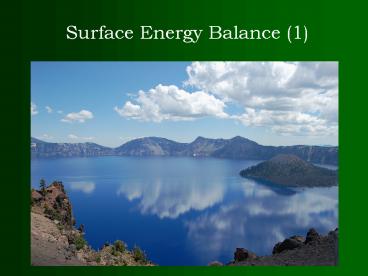Surface Energy Balance (1) - PowerPoint PPT Presentation
1 / 21
Title:
Surface Energy Balance (1)
Description:
Title: Chapter 2: Solar Radiation and the Seasons Last modified by: Jialin Lin Document presentation format: On-screen Show (4:3) Other titles: Times New Roman MS P ... – PowerPoint PPT presentation
Number of Views:105
Avg rating:3.0/5.0
Title: Surface Energy Balance (1)
1
Surface Energy Balance (1)
2
Review of last lecture
- The current status of weather and climate
predictions (1) weather prediction good to 10
days, (2) tropical cyclone prediction good in
track but not in intensity, (3) climate
prediction good to two seasons, (4) climate
change projections have a 3-fold difference in
magnitude. - The main reasons of the difficulties (1)
Teleconnection problem, (2) Feedback problem, and
(3) Subgrid-scale problem. - Importance of the ABL (1) interface between
atmosphere and ocean/land/ice - flux transfer and
feedback, (2) the human beings are living in the
ABL and change the environment, (3) a basic
subgrid-scale process
3
Energy basics
- Energy the ability to do work
- Many forms electrical, mechanical, thermal,
chemical, nuclear, - Joule (J) standard unit of energy (1 J 0.239
calories) - Watt (W) rate of energy flow (W 1 J/s)
4
Methods of Energy Transfer
- Conduction
- Molecule to molecule transfer
- Heat flow warm to cold
- e.g. leather seats in a car
- Convection
- transferred by vertical movement
- physical mixing
- e.g. boiling water
- Radiation
- propagated without medium (i.e. vacuum)
- solar radiation provides nearly all energy
- The rest of this chapter deals with radiation
5
Radiation
- Everything continually emits radiation
- Transfers energy in waves
- Waves are both electrical and magnetic, hence
electromagnetic radiation
6
Radiation Quantity and Quality
- Quantity how much? ?
- Wave height (Intensity).
- Quality what kind? ?
- Wavelength distance between crest and crest
(or trough and trough). generally reported in µm
(microns)- one millionth of a meter.
7
The Electromagnetic Spectrum
The limitations of the human eye!
8
A man detected by different instruments
Infred device
Bare eyes
X-ray
Microscope
9
Wavelength of Sun and Earth Radiation
Sun shortwave (0.4-0.7 µm) Peak 0.5 µm
(green)
Sun
Earth longwave (4-100 µm) Peak 10 µm
(infrared)
10
Composition of sunlight
11
Physical Representation of Radiation
- Blackbodies purely hypothetical bodies that
absorb and emit the maximum radiation at all
wavelengths - The Earth and the sun are close to blackbodies.
- The atmosphere is not close to blackbody, but it
can served as the first order approximation
12
Intensity Stefan-Boltzmann Law
- States that radiation emitted from a blackbody is
a function ONLY of temperature - Hotter bodies emit more energy than colder bodies
- I?T4
- where I is the intensity of the radiation, T is
the temperature in K, and ? is the
Stefan-Boltzmann constant, 5.67 x 10-8 W m-2 K-4) - So, double T, 16x more radiation
- Earth (290K) 401 Wm-2, Sun (6000K) 7.3 x 106
Wm-2. So ISun gtgt IEarth
13
Wavelength Wiens Law
- Details the wavelength of peak emission of a body
based on its temperature - ?max 2900 / T
- where ? is the wavelength of maximum emission (in
?m) and T is temperature (K) - Thus, the Earth (290K) 10 ?m, and Sun (6000K)
0.5 ?m - Weins Law tells us that hotter objects radiate
at shorter wavelengths than cooler bodies - All bodies emit radiation over a range of
wavelengths centered about the maximum predicted
from Weins Law
14
Satellite Measurements of the Earths Radiation
Budget
NASAs Earth Radiation Budget Satellite (ERBS)
1985-1989
NASAs Clouds and the Earth's Radiant Energy
System (CERES) on 4 satellites (TRMM, Terra,
Aqua, NPP) 2000-now
15
Video Monitoring Earth's Energy Budget with
CERES
- http//www.youtube.com/watch?vD_Qmue54W14
16
Earths energy budget (averaged over the whole
globe and over a long time)
Yellow shortwave
Red longwave
Sensible heat 7
Net Longwave 21
Latent heat 23
- At the top of the atmosphere
- Incoming shortwave Reflected Shortwave
Emitted longwave - At the surface
- Incoming shortwave Incoming longwave
Reflected shortwave Emitted longwave - Latent
heat flux Sensible heat flux Subsurface
Diffusion
17
Latitudinal variation of surface net radiation
- Tropics energy surplus
- High latitudes energy deficits
- Imbalance of heating between tropics and high
latitudes drives global atmospheric circulation
(the 3-cell model)
18
Seasonal variation of surface radiation
19
Surface sensible and latent heat fluxes
- Both are turbulent (noisy) fluxes related to
conduction and convection. - Both proportional to surface wind speed.
- Sensible heat flux is dry flux from warm to cold
regions - Latent heat flux (also called evaporation) is wet
flux from wet to dry regions. Latent heat of
evaporation is stored in water vapor and will be
released when condensation (clouds/precipitation)
happens.
Surface Wind
From NOAA ESRL
20
Seasonal variation of surface energy budget
Storage change net radiation - latent heat flux
- sensible heat flux
21
Summary
- What is energy? 3 methods of energy transfer
- The names of the 6 wavelength categories in the
electromagnetic radiation spectrum. The
wavelength range of Sun (shortwave) and Earth
(longwave) radition - Intensity of radiation (Stefan-Boltzman law)
I?T4 - Wavelength of radiation (Weins law) ?max b/T
- Earths energy balance at the top of the
atmosphere. - Incoming shortwave Reflected
Shortwave Emitted longwave - Earths energy balance at the surface.
- Incoming shortwave Incoming longwave
Reflected shortwave - Emitted longwave Latent heat flux
Sensible heat flux - Subsurface conduction































